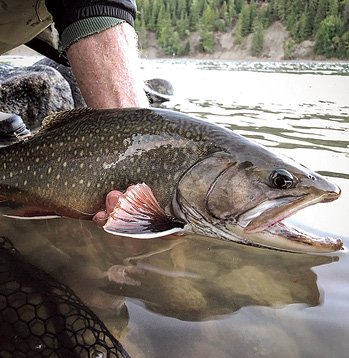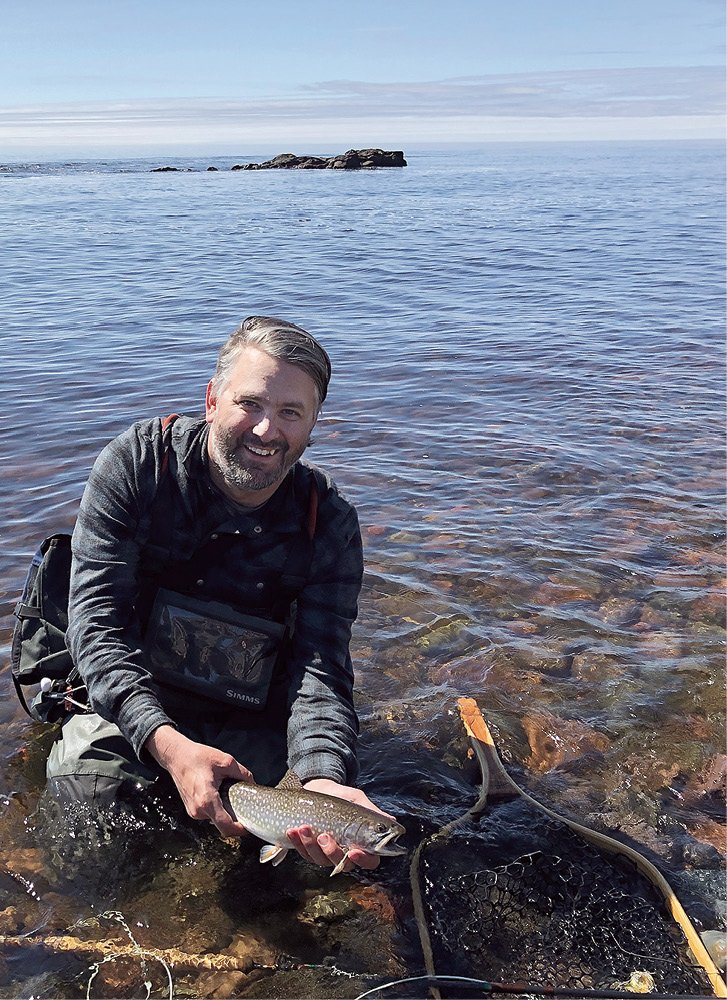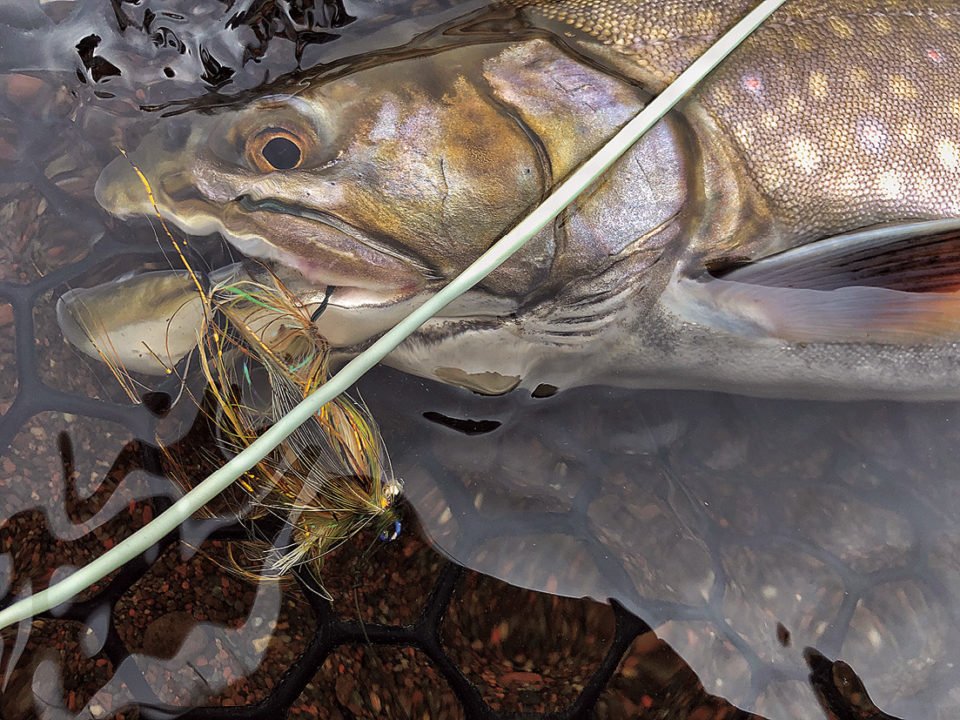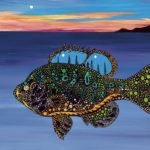When is a brook trout like an onion? One answer may be when it is fried golden brown. But a better answer is when Lake Superior fish managers and researchers team up to take multiple approaches to learn more about this native fish.
The brook trout lives in cold streams running into Lake Superior, as well as in the lake itself. In streams, it is typically a small fish, averaging less than 12 inches in length. In Superior, it is capable of growing much larger, possibly reaching 24 inches or more. In the 1800s, Lake Superior’s giant brook trout, now called coasters, attracted sport anglers from around the world. Unfortunately, during the 20th Century, a combination of factors ranging from overfishing to poor land use practices decimated Superior’s coasters until only remnant populations remained at places like Ontario’s Nipigon Bay and Isle Royale. Now, in the 21st Century, fish managers are trying to restore coasters wherever it is possible to do so.
A variety of trout and salmon swim in Lake Superior and its tributaries, but most were introduced from the Pacific coast or Europe. The only natives are brook trout, lake trout and closely related whitefish. After nearly being wiped out by predation from invasive sea lamprey and overfishing, lake trout were successfully rehabilitated during the latter half of the 20th Century. Whitefish remain common in much of the lake and are harvested commercially. Brook trout are abundant in Superior’s tributaries, but remain sparsely populated in most of the lake, including Minnesota, where they frequent shorelines, bays and nearshore waters.
Nick Peterson, Minnesota DNR fishery specialist stationed at French River, makes an analogy to layers of an onion when he describes current efforts in Minnesota and lakewide that use advanced scientific tools and analysis to learn more about brook trout in the Lake Superior basin. They are trying to find answers to some questions. Are there genetic differences between brook trout living in streams and those living in the big lake? Were brook trout native above the waterfalls that create barriers to upstream migration? If there are differences between stream and lake dwellers, is it a function of habitat or something else?
“We’re trying to get a holistic picture of brook trout genetics,” Peterson said.

On a lakewide basis, the Cooperative Science and Monitoring Initiative is studying maxillary bones collected from brook trout above and below migration barriers to determine life histories, such as whether an individual fish is a stream resident or migrates to and from the lake. A laser directed at the bone can follow the fish’s life history and determine from elements collected in the bone whether the fish was in the stream or spending time in the lake. Researchers aren’t sure whether coasters are migratory like salmon, leaving the stream at a young age and returning later to spawn, or if they move between the stream and lake depending on stream conditions and water temperature. Researchers know from historic accounts that coaster brook trout were once bigger and more abundant than they are today. But they don’t know how habitat degradation or other factors influence the present population.
That said, coaster brook trout are becoming somewhat larger and more abundant in Minnesota waters, due in no small part to protective regulations that reduce the bag limit to one fish at least 20 inches in length. In the not-to-distant past, anglers were allowed to keep 10 brook trout of any size, which generally assured the good tasting fish were taken home for dinner.
While anglers don’t catch large numbers of coasters along Minnesota’s North Shore, the ones they do catch can be sizeable. Pictures of Minnesota coasters appear on social media, which amplifies anglers’ enthusiasm for catching them. Social media also helps promote interest in coaster brook recovery.
In the management of Lake Superior’s fisheries, coasters have long played second fiddle to other trout and salmon, which are larger, common and desired by a broad swath of anglers. But Peterson said the DNR’s Lake Superior office is placing a higher priority on coasters moving forward.
“The natives are meant to be here,” he said. “We still need to be realistic about coaster management. Population rehabilitation will take time. Coasters in Minnesota are limited by habitat, so habitat protection and enhancement are our number one priority.”

Brook trout are fall spawners, so the DNR conducts fall electrofishing stream surveys every three years to evaluate spawning populations. The agency also conducts some summer lake electrofishing surveys in nearshore areas such as bays, harbors and marinas to count and tag adult brook trout. Genetic samples collected during electrofishing surveys help determine the status of the population. Minnesota biologists are curious whether some of the large brook trout caught by anglers are actually splake, a hatchery created lake trout/brook trout hybrid stocked by Wisconsin. They also look to see if some of the brook trout originate from stockings of hatchery fish by the Grand Portage Ojibwe. So far, they found minimal evidence of hatchery-derived fish.
“Most of the biggest brook trout in fall surveys are wild Minnesota brook trout,” Peterson said.
Ongoing genetic analysis by the DNR and a coalition of fisheries agencies around the lake is developing a genetic baseline for brook trout in the Lake Superior basin that will hopefully lead to point where biologists can identify brook trout by the stream where they were born. Peterson also hopes to determine if brook trout were native above the barrier falls that block upstream passage by fish from Lake Superior. Biologists have thought brook trout were stocked above the barriers early in the logging era, but it is possible they’ve existed, at least in some waters, since the era of Glacial Lake Duluth. The more biologists can learn about the original native brook trout, as well as contemporary populations, the better they can foster their recovery.
One hundred and fifty years ago, anglers caught brook trout by the barrelful. Given the habitat changes and introductions of non-native species to Lake Superior that have occurred since then, it seems unlikely coaster brook trout will ever recover to that abundance. But it is possible the population can be restored to the point where anglers have a reasonable expectation of catching a trophy-sized coaster. For brook trout anglers and biologists, that is reason enough to proceed with recovery efforts.





